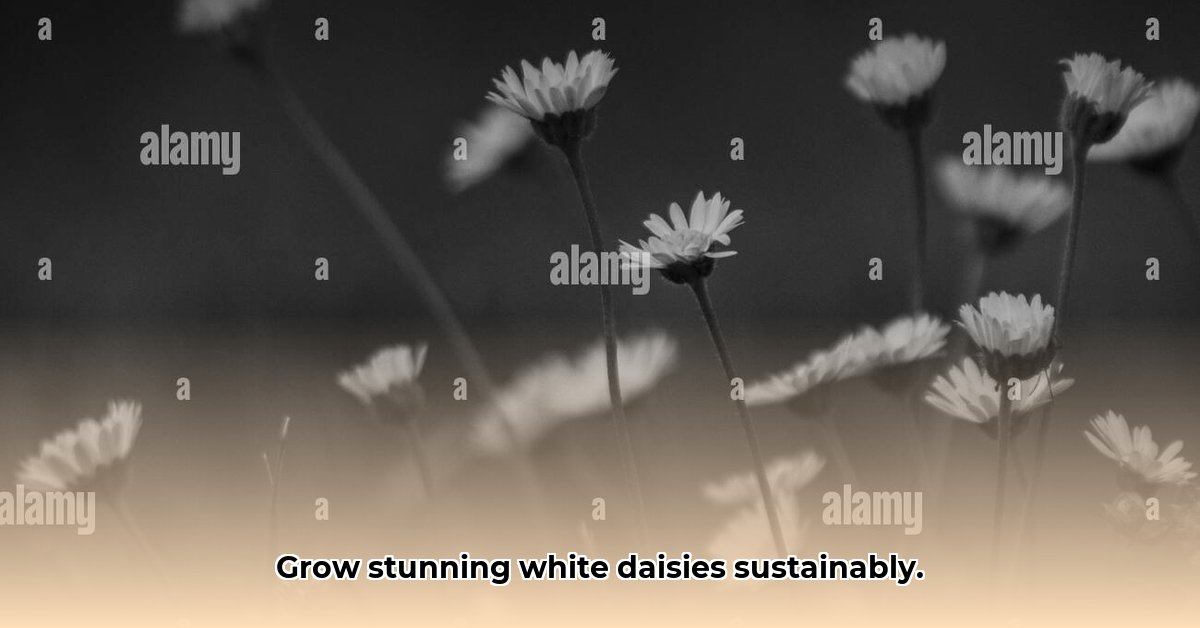
Growing white daisies sustainably isn't just about pretty flowers; it's about creating a thriving garden that benefits both you and the environment. This guide provides step-by-step instructions for selecting the right daisies, preparing your garden, planting, caring for your blooms, and ensuring long-term success. For more information on white daisy varieties, check out this helpful guide: White Daisy Guide. Let's get started!
Choosing the Right Daisies: A Blooming Good Start
Selecting the perfect white daisies is crucial for a beautiful and sustainable garden. Consider your location's climate and soil type. Some daisies thrive in full sun, while others prefer partial shade. Daisies generally prefer well-draining soil. Poor drainage can lead to root rot.
Native daisy species are often the best choice because they're already adapted to your local conditions, requiring less care and water. Visit your local garden center for expert advice on suitable varieties for your area. Don't just rely on online pictures; talk to a knowledgeable professional! Consider the desired look – tall, stately blooms or a delicate groundcover? Different varieties offer diverse heights, growth habits, and bloom sizes.
Site Preparation: Setting the Stage for Success
Before planting, prepare your garden bed. This lays the foundation for healthy, happy daisies.
- Clear the Area: Remove weeds, rocks, and existing vegetation. A weed-free environment minimizes competition for nutrients and water.
- Amend Your Soil: Improve drainage, fertility, and water retention by adding compost (a natural soil amendment rich in nutrients). Compost enhances soil structure, promoting healthy root development. Aim for at least 3 inches of compost mixed into the topsoil.
- Loosen the Soil: Dig down deep to break up compacted areas. This improves aeration, allowing roots to breathe and grow effectively. Good soil aeration is essential for healthy daisy growth.
Planting and Care: Helping Your Daisies Thrive
Planting is straightforward but requires attention to detail.
- Dig Holes: Make holes slightly larger than the daisy root balls.
- Gently Place Daisies: Ensure the crown (the base of the stem) is level with the ground.
- Water Thoroughly: Water gently but deeply after planting.
- Avoid Overwatering: Overwatering can be detrimental; infrequent, deep watering is preferable. Monitor soil moisture and water only when the top inch feels dry.
- Watering Methods: Consider drip irrigation for efficient water delivery directly to the roots, minimizing water waste through evaporation. Drip irrigation systems can significantly reduce the amount of water needed.
- Weeding: Regularly remove weeds to prevent competition for resources. Weeds can rob your daisies of essential nutrients and moisture.
- Mulching: Apply a layer of mulch (straw, wood chips) to retain soil moisture, suppress weeds, and regulate soil temperature. Mulching reduces watering frequency and minimizes weed growth.
Long-Term Sustainability: Building a Thriving Ecosystem
Sustainable gardening is an ongoing process.
- Soil Health Monitoring: Regularly test your soil to monitor nutrient levels. Soil testing kits are readily available at most garden centers. Adjust fertilization based on results to ensure optimal daisy health.
- Biodiversity Enhancement: Incorporate companion plants that deter pests or improve soil quality. This promotes a healthy ecosystem. Companion planting can reduce the need for chemical pest control.
- Variety Rotation: Rotate different daisy varieties every few years to reduce the risk of soilborne diseases and pest infestations. Crop rotation maintains healthy soil and prevents pest buildup.
- Expansion: Once your daisy patch is thriving, consider expanding your sustainable garden. This is an environmentally friendly approach to landscaping.
Troubleshooting Common Issues: Addressing Challenges
Even experienced gardeners face challenges.
| Problem | Possible Solutions |
|---|---|
| Yellowing Leaves | Overwatering, nutrient deficiency, pest infestation. Check soil moisture and conduct a soil test. |
| Pest Infestation | Introduce beneficial insects (like ladybugs), use organic pest control methods, or handpick pests. |
| Slow Growth | Poor soil drainage, nutrient deficiency. Improve soil drainage and amend with compost or fertilizer. |
| Poor Blooming | Insufficient sunlight, improper watering. Ensure adequate sunlight and adjust watering according to the plants' needs. |
Remember, patience and observation are key to sustainable gardening. Don't be afraid to experiment and learn from your experiences. Happy Gardening!
Key Takeaways:
- Drought-tolerant daisies conserve water and reduce your environmental impact.
- Choosing the right daisy varieties for your region is paramount for success.
- Proper soil preparation, planting, and consistent care are crucial for healthy, happy daisies.
- Sustainable practices like mulching, drip irrigation, and biodiversity enhancement create a thriving ecosystem.